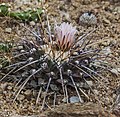Thelocactus tulensis
| Thelocactus tulensis | |
|---|---|

| |
| Scientific classification | |
| Kingdom: | Plantae |
| Clade: | Tracheophytes |
| Clade: | Angiosperms |
| Clade: | Eudicots |
| Order: | Caryophyllales |
| Family: | Cactaceae |
| Subfamily: | Cactoideae |
| Genus: | Thelocactus |
| Species: | T. tulensis
|
| Binomial name | |
| Thelocactus tulensis | |
| Synonyms | |
| |
Thelocactus tulensis is a species of cactus. It is endemic to Mexico.
Description
[edit]Thelocactus tulensis is a solitary, spherical cactus, sometimes slightly elongated, with a dark dull green body up to 25 centimeters high and 8 centimeters in diameter. It has 10 ribs that are bulbous to cone-shaped, up to 2 centimeters high and in diameter, with thick, fleshy warts that have many edges. The areoles are woolly when young, at a distance of 2.5 centimeters, and later become naked. It has 6 to 8 radial spines that are initially brownish and then turn white, measuring only 1 to 1.5 centimeters long. Additionally, it has 1 to 3 central spines that are up to 4 centimeters long, straight or curved, and whitish to horn-colored with a dark tip.
The flowers of Thelocactus tulensis are widespread, measuring 2.5 to 5 centimeters long and 3.5 to 8 centimeters in diameter. Their color varies from silvery white to delicate pink, with a carmine red central stripe. The scar of the flower is pale yellow. The fruits are green to greenish-magenta or whitish-brown, measuring 11 to 18 millimeters long and about 7 to 10 millimeters in diameter. The seeds are dark with a finely tuberous testa cell pattern.[2]
-
Flower buds
-
Plant habit
Distribution
[edit]Thelocactus tulensis is native to the limestone hills in the Chihuahuan Desert in Tamaulipas, Nuevo León, and San Luis Potosí, Mexico at elevations of 1200 to 1900 meters.[3]
-
Plant growing near Rayones, Nuevo Leon
-
Plant growing in habitat near San Roberto
Taxonomy
[edit]First described as Echinocactus tulensis in 1853 by Heinrich Poselger, the species was later placed in the genus Thelocactus by Nathaniel Lord Britton and Joseph Nelson Rose in 1923.[4] The specific epithet "tulensis" refers to the occurrence of the species near Tula in Mexico.[5]
References
[edit]- ^ Sotomayor, M.; Gómez-Hinostrosa, C.; Hernández, H.M.; Smith, M. (2017). "Thelocactus tulensis". IUCN Red List of Threatened Species. 2017: e.T152910A121616648. doi:10.2305/IUCN.UK.2017-3.RLTS.T152910A121616648.en. Retrieved 12 November 2021.
- ^ Anderson, Edward F. (2001). The Cactus Family. Portland, Or: Timber Press (OR). p. 662–663. ISBN 0-88192-498-9.
- ^ "Thelocactus tulensis". LLIFLE. 2013-08-04. Retrieved 2024-05-11.
 This article incorporates text from this source, which is available under the CC BY-SA 3.0 license.
This article incorporates text from this source, which is available under the CC BY-SA 3.0 license.
- ^ Dietrich, Albert; Otto, Friedrich (1853). "Allgemeine Gartenzeitung". Biodiversity Heritage Library. Retrieved 2024-05-11.
- ^ Britton, Nathaniel Lord; Eaton, Mary E.; Rose, J. N.; Wood, Helen Adelaide (1919). The Cactaceae : descriptions and illustrations of plants of the cactus family. Washington: Carnegie Institution of Washington. doi:10.5962/bhl.title.46288.
External links
[edit] Media related to Thelocactus tulensis at Wikimedia Commons
Media related to Thelocactus tulensis at Wikimedia Commons Data related to Thelocactus tulensis at Wikispecies
Data related to Thelocactus tulensis at Wikispecies





